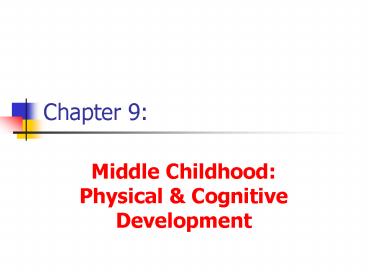Middle Childhood: Physical - PowerPoint PPT Presentation
Title:
Middle Childhood: Physical
Description:
Chapter 9: Middle Childhood: Physical & Cognitive Development Focus on homework #4 * Competencies underlying intelligence manifest themselves during middle childhood ... – PowerPoint PPT presentation
Number of Views:483
Avg rating:3.0/5.0
Title: Middle Childhood: Physical
1
Chapter 9
- Middle Childhood Physical Cognitive Development
2
Growth Patterns in Middle Childhood
- Body weight doubles
- Spend much energy on physical activity and play
- School children eat much more than preschoolers
- Boys slightly heavier taller until 9-10, then
girls enter adolescence. Boys enter adolescence
3-4 years after girls - Boys ? muscle, girls ? fat
3
Motor Skills
- Gross Motor
- by 6 Hopping, jumping
- 6-7 climbing, pedaling/balancing on a bike
- 8-10 Better balance, coordination and strength
- Fine Motor
- By 6-7 Tie shoes, hold pencil as adults, fasten
buttons, zippers, brush teeth, wash themselves,
coordinate a knife and fork, skill at using
chopstick greatly improves
4
Question
- What is reaction time?
5
Cognitive Development
- Remember, Piaget believed that school age
children (age 7-12 yrs) are in the concrete
operational stage of development. - What is meant by Concrete Operations? The
development of mental operations Cognitive
actions that can be performed on objects or ideas
and that consistently yield results.
6
Concrete Operational Thinking
- Children show the beginnings of adult logic but
they generally focus on tangible objects rather
than abstract ideas this is why they are
concrete. - Children begin to understand that events can be
interpreted in different ways, thus looks can be
deceiving. - They have developed reversibility and flexibility
in thinking.
7
Concrete Operational Thinking is Characterized
by
- Less egocentrism (can view the world from another
persons perspective realize that others may see
things differently then them) - Engaging in decentration (they can focus on more
than one dimension or aspect of a problem at the
same time) - Understanding conservation (objects can have
several properties or dimensions)
8
Concrete Operational Thinking is Characterized
by, cont.
- Understanding transitivity If A exceeds B in
some property (like age or height) and if B
exceeds C, then A must also exceed C - Understanding class inclusion Can focus on two
subclasses (dog/cats) and larger subclasses
(animals) at the same time. Example with the are
there more dogs or animals? from last week
9
Example of Transitivity
Seriation
10
Kohlberg's Theory of Moral Development
- Focused on the kinds of information children use
to determine whether a situation is right or
wrong. - Emphasized the importance of being able to view
the moral world from the perspective of another
person. - Children and adults arrive at moral judgments
based on different reasoning skills, which can be
classified according to certain stages of moral
development. (according to Kholberg)
11
Kohlberg's Theory of Moral Development, cont.
- Developmental stages of moral reasoning follow
the same sequence in all children. - Children progress at different rates, and not
everyone reaches the highest stage.
12
Intellectual Development vs. Achievement
- Intelligence A measure of a childs underlying
competence or learning ability. Associated with
academic success, advancement on the job, and
appropriate social behavior. - Achievement Involves a childs acquired
competencies or performance.
13
Theories of Intelligence
- 1. Sternbergs Triarchic Theory of Intelligence
Believed there are three parts to our
intelligence. - Intelligence is defined as using our abilities
skillfully to achieve our personal goals. - Instruction is most effective when it is geared
to a childs strength.
14
(No Transcript)
15
Theories of Intelligence, cont.
- 2. Garners Theory of Multiple Intelligences
Believed each intelligence reflects more than
academic ability. - Believed each has its neurological basis in
different parts of the brain. - Believed each is an inborn talent that must be
developed through educational experiences if it
is to be expressed. - Each intelligence differs in quality.
16
(No Transcript)
17
Measuring Intellectual Development
- Use of the Weschler tests
- Widely used and most respected
- Yield an Intelligence Quotient (IQ)
- Carefully developed revised over the years
- Used to make educational decisions for
children/adults - May be culturally biased
18
Know
- No single test should ever be used to determine a
childs intelligence!
19
The Weschler Scales
- Yields a verbal and performance IQ based on
persons performance on subscales, and an overall
full IQ score - Helps reveal a childs strengths and weaknesses
and provides a measure of their overall
intellectual functioning - Specific test given based on the age of the
person being tested
20
(No Transcript)
21
(No Transcript)
22
Fig. 9-10, p. 183
23
What Determines our Intellectual Development?
- 1. Heredity
- Heritability of intelligence is approximately
40-60 - 2. Environment
- Early enrichment
- Varied experiences
- Preschool (Headstart, etc.)
- Responsive parents































